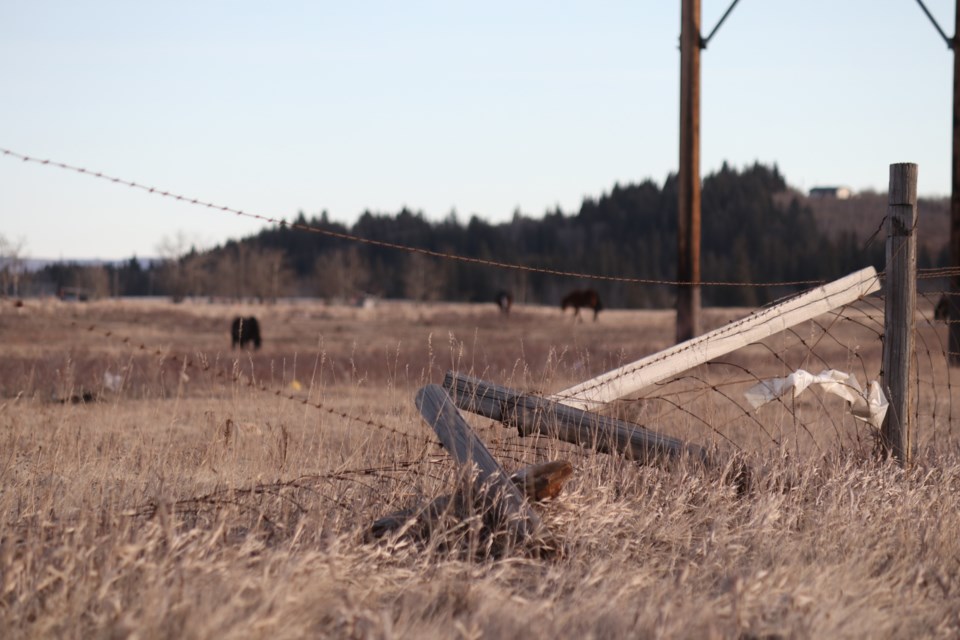STONEY NAKODA – Six feral or domesticated horses have been hit and killed on Highway 1 in Stoney Nakoda First Nation in the past six months, fueling concerns over safety and provincial highway fencing.
Three privately-owned horses were struck and killed in November 2022 in a single incident along the Trans-Canada Highway near the junction of Highway 40 after it was believed the animals crossed over damaged fencing and roamed onto the road.
“It’s very frustrating for people living on the Nation and the ranchers that are around those areas,” said Stoney Nakoda’s protective services manager Pascal Richard. “Highway fencing has always been an issue.”
More than 200 feral horses currently roam the First Nation, according to Richard, who previously worked as a police officer in the area for 25 years.
“It’s been an issue for years and years,” he said. “Speaking on behalf of the Nation, we believe that the government should be fixing the fences on provincial highways.
“In my mind, though, it needs to be fixed completely – like redone.”
The Trans-Canada, built in the area in the 1950s, runs through roughly 30-kilometre of Nation lands, where either side of the highway is lined by a four-foot wood and wire fence.
But the fence is showing its age, Richard said, and it’s not uncommon to see areas where it’s been heavily patched, is leaning, or has just fallen down.
“If you look at the fencing, it’s been stretched and some posts have been added and some of it’s just rotten,” he said. “It’s really not in good shape.”
Volker Stevin, the province’s highway contractor responsible for removing roadkill and responding to incidents where wildlife are involved in collisions, is called upon to fix broken fencing where vehicles have run off the highway.
Part of the company’s budget also includes patrolling highways for hazards, said operations manager Dean Jetten.
“We patrol the highways on a regular basis as part of our contract with the province,” he said. “We look for hazards and if we see a fence that’s damaged, we’ll fix it, or if we see an animal that’s out, we’ll call RCMP because we don’t want those things to become hazards.”
Jetten stressed the importance of communication between Volker Stevin, Stoney Nakoda First Nation and the Alberta government to ensure risks are mitigated where possible.
Whenever a wildlife-vehicle strike report is made, as long as the animal isn’t removed before Volker Stevin can respond, it’s recorded on a 511 app and the data is tracked by the province to determine areas of higher risk, where mitigation measures may be required.
When an animal carcass is reported, highway contractors are responsible for removing it within one hour of the initial report. However, in the case of livestock, owners must be contacted first.
“Say a deer or a moose gets hit, we’ll respond and then record it on the app and it goes to a database,” said Jetten. “But if people or groups are removing that roadkill before we get there, for whatever reason, then the data isn’t going to be as accurate.”
To mitigate wildlife safety concerns, the province currently plans to add 15 to 20 km of fencing from Seebe, where Stoney Nakoda’s lands end to the west, to Dead Man’s Flats.
While conversations have been ongoing between Stoney Nakoda, the province and Volker Stevin, Richard said mitigation efforts aren’t happening as quickly as he’d like to see on the First Nation’s lands.
“I’m pretty new in this position and we’ve established pretty good communication, but I’ve had some difficulty trying to get a hold of Alberta Transportation to see if we can move this along faster and get those things done,” he said.
Highway 1A, which runs adjacent to the Trans-Canada to the north and is notoriously narrow with little to no shoulder, has some of the same issues with fencing and animals on the road, primarily livestock.
The province has been talking about widening the 1A for about a decade, which has been a barrier in advocating for improved fences along the roadway, Richard said.
“They’re always saying, ‘we’ll do it next year,’ and that’s gone on for a while now. So, they’re not going to spend any money on the fence right now when they know they’ll have to move it eventually.”
In a statement emailed to the Outlook, Jesse Furber, press secretary for the Ministry of Transporation and Economic Corridors said, “The Stoney Nakoda First Nation has shared concerns about repairs that may be required on fencing to reduce incidents of livestock at large on Highway 1.
“While landowners are typically responsible for maintaining fencing along provincial highways, Alberta Transportation and Economic Corridors has agreed to help offset some of these costs by paying the highway maintenance contractor, Volker Stevin, to complete any necessary repairs along wildlife fencing on Highway 1 in Southern Alberta.
“Volker Stevin has been in touch with the Stoney Nakoda First Nation to identify areas of fencing that require repairs and to complete the work.”
Richard said his understanding is when Trans-Canada construction negotiations happened between the First Nation and the province in the 1950s, that it would be on the Alberta government to repair highway fencing as required. However, he said they have not been able to find the paperwork to back this in their advocacy.
Ultimately, though, safety should be of highest concern over responsibility or cost, he said.
“It would be good to have a fence like they’re building from Seebe to Dead Man’s – which I understand will be about six to eight feet tall – along the highway through the reserve, but we’ve been told that’s not going to happen because that’s a very expensive fence.
“But I do believe public safety is more important than the price of a fence.”
The Local Journalism Initiative is funded by the Government of Canada. The position covers Îyârhe (Stoney) Nakoda First Nation and Kananaskis Country.




